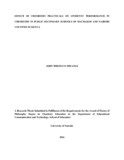| dc.description.abstract | The purpose of this study was to investigate the effect of chemistry practicals on students‟ performance in chemistry in Machakos and Nairobi counties‟ public secondary schools. The main objective of the study was to establish if there is any significant difference in academic achievement in chemistry between students exposed to chemistry practicals and those not so exposed. This was against the backdrop of the need to find out the appropriate role played and the reality of what is actually achieved by chemistry practicals especially with continued decline in academic performance in secondary school chemistry. The specific objectives of the study were to: evaluate the effect of the nature of chemistry practicals, examine the effect of quality of chemistry practicals and the effect of frequency of chemistry practicals on students‟ performance in secondary school chemistry. Other areas investigated were the relationship of chemistry practicals and performance in chemistry between students of mixed gender schools and those of single gender schools. Learners‟ performance in chemistry was determined by scores obtained by students in Students Achievement Tests (SAT) done just before and immediately after exposure to the topic under investigation. Data relating to teachers‟ and students‟ views on the use or non use of chemistry practicals and its effects on performance in chemistry were collected using questionnaires. The computer package SPSS (Statistical package for social scientists) was used to analyze the data. Descriptive statistics such as frequency, mean, percentages, and standard deviation was used to discuss the research findings. The study also used inferential statistics such as ANOVA, ANCOVA, independent T-test and multiple regression to test the statistical significance in the four null hypotheses generated for the study. It was found that the use of chemistry practicals in teaching and learning of chemistry at secondary school level, improved performance in the subject. There was a difference between the mean scores in the post test of the students of both groups. The mean score for experimental group was (15.73) whereas it was (14.18) for the control group. The t-test value was (4.47) at p = 0.00, that is, a significant level at p ˂ 0.05 which indicated that there was a significant difference in performance of the experimental and the control group. That is, the students exposed to chemistry practicals scored significantly higher in the achievement test than those not exposed. The ANOVA results ( F= 74.2, p = 0.00), a significance level at p ˂ 0.05 and (F= 132.7, P = 0.00), that is a significance level at p ˂ 0.05 showed that a strong relationship existed between performance in chemistry and nature, and frequency respectively, of chemistry practicals used in the teaching and learning of chemistry. It was further found that a majority of students (68.8% and 76.6%) respectively agreed that the use of chemistry practicals makes learning to be enjoyable to students and increases their understanding of concepts. In addition, it was observed that pressure to cover the syllabus is not an obstacle to using of chemistry practicals as a teaching and learning method. The study recommended that students be given an opportunity to engage in „deep learning‟ during chemistry practicals and that there should be further study on the curriculum and learning standards for chemistry practicals in secondary school Chemistry and that due consideration should be paid to improving school conditions and teachers‟ capacity, for effective implementation of chemistry curriculum. The researcher further recommends that information and communication technology (ICT) should be integrated in the teaching and learning of chemistry, especially in chemistry practicals since the computer and its Internet access have a lot of potential of improving chemistry performance. | en_US |



